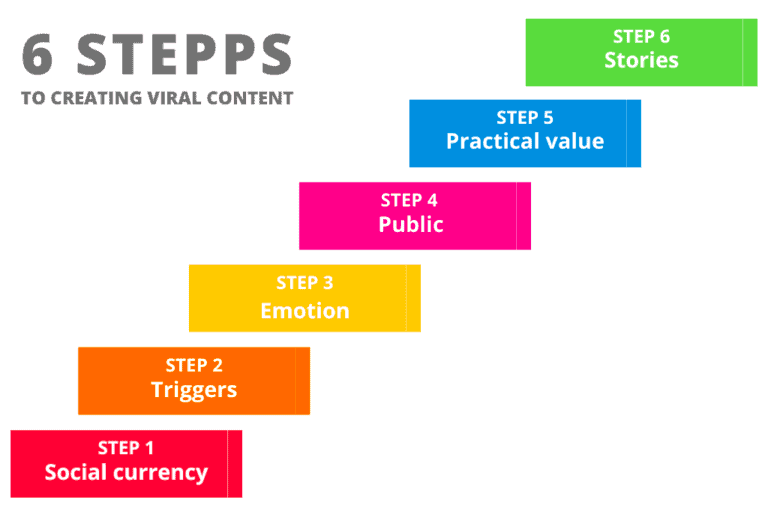Understanding the human psyche behind the share button can be a game-changer for anyone looking to leave their mark on the digital landscape.
Did you know that 44% of smartphone users can’t imagine life without social media? This statistic alone underscores the significance of decoding the science behind social media trends.
What is Viral Content?
Viral content refers to digital material that spreads rapidly and widely across social media platforms, often garnering significant user attention and engagement. It can manifest in various formats, from videos and memes to images and text-based posts.
The phenomenon of content going viral can occur organically, driven by user enthusiasm and sharing, or as a result of a carefully planned marketing campaign.
The impact of viral content can be substantial, providing brands or individuals with increased visibility, extended reach, and heightened engagement with their target audience. However, it also presents challenges, including managing a high volume of user interactions, potential negative feedback, and the risk of the content being misinterpreted or causing unintended harm.
Understanding viral content and its operation is crucial for anyone looking to harness its potential in social media and digital marketing.
The Elements of Viral Content
The Elements of Viral Content” encompasses the crucial components that drive the widespread sharing and engagement of digital material. Jonah Berger, a renowned marketing professor and social influence expert, extensively analyzed numerous viral content pieces to unveil the underlying motivations for sharing.
This research unveiled six key elements, often distilled into the acronym “STEPPS,” as highlighted in his book, “Contagious: Why Things Catch On.” These elements include:
- Social Currency: How content makes the sharer look good or enhances their social standing.
- Triggers: The cues and reminders that prompt people to share content.
- Emotion: The emotional resonance that makes content more shareable, whether humorous, heartwarming, or thought-provoking.
- Public: The visibility of sharing, where others can see what you’ve shared.
- Practical Value: Content that offers helpful information or solutions to problems.
- Stories: The narratives that capture attention and create a lasting impression.

Social Currency
Social Currency is a concept rooted in people’s desire to be positively perceived by others. It revolves around the idea that individuals often aim to cultivate a self-image that aligns with specific characteristics, such as intelligence, fashion, or fascination.
In the context of social media, a person’s standing or reputation is frequently influenced by the information they share and how it reflects on them. Content that serves as “social currency” possesses the potential to go viral effortlessly.
Everyone desires to be perceived as “in the know” or possessing insider information. Whether individuals share the latest recommendations, impart knowledge, or achieve something remarkable, content that embodies social currency is exceptionally shareable.
Incorporating Social Currency into Your Content
By understanding your audience’s aspirations and the impression they seek to make, you can create content that resonates with them and enhances their online image when shared.
According to Jonah Berger, there are three key ways to infuse social currency into your content:
- Remarkability: Craft content that is unique, cool, and shareable. Encourage your audience to share your content because it’s extraordinary, addressing their curiosity and desire to be associated with remarkable discoveries.
- Game Mechanics: Engage your audience by transforming them into active participants in your content. Create interactive elements or tools within your content that maintain their interest and add an extra layer of remarkability.
- Exclusivity: Make your audience feel like insiders by providing exclusive access to valuable information or resources that can’t be found elsewhere. This sense of exclusivity can make them feel essential and compel them to share your content within their networks.
Triggers
Triggers in content and branding refer to words, phrases, or images that are closely associated with a specific message, product, or brand. These triggers can evoke thoughts and conversations related to that message or brand, even when no active marketing or messaging campaign is in progress.
For example, seeing an American Pekin duck might immediately bring the insurance company Aflac to mind, thanks to their iconic advertising campaign featuring a duck.
Triggers are essential because they inspire people to talk about your brand or message spontaneously. As Jonah Berger emphasizes, maintaining consistency with triggers is crucial, as “top of mind means the tip of the tongue.”
When your brand or message is top of mind, it will likely be shared in conversations. Establishing and maintaining triggers can significantly expand your reach and make word-of-mouth marketing more natural and effective.
Incorporating Triggers into Your Content
Incorporating Triggers into Your Content involves strategically infusing your content with elements that inspire your audience to seek information, share your content, and associate your brand or publication with specific events, activities, or situations.
This strategic approach aims to answer questions like What motivates your audience to seek information from you? When and where do they turn to you for guidance?
Practical triggers should possess the following qualities:
- Unique: Your trigger should be distinctive and exclusively associated with your content or brand. It sets you apart from the competition and ensures that when people encounter it, they think of you.
- Encountered Frequently: For a trigger to be effective, your audience should come across it frequently in their environment. The more they experience it, the more likely it is to stay top of mind.
- Long-lasting: Ideally, triggers should remain relevant to your audience and their environment for an extended period. This ensures that your content continues to be associated with specific triggers over time.
Emotion
Emotion is the third crucial element in Jonah Berger’s viral content formula. It centers on the understanding that people are inclined to share content that resonates with their emotions and touches on topics or stories they genuinely care about.
Humans naturally gravitate towards discussing their feelings, and it’s a well-established fact that we tend to share content that stirs our emotions.
The brain’s limbic system plays a vital role in processing emotions, and neuroscientific studies have revealed that when we engage in conversations about feelings, the brain’s activity shifts to regions responsible for language and meaning.
This phenomenon explains why individuals often find relief in venting or eagerly sharing exciting news with others.
Incorporating Emotions into Your Content
To achieve this, it’s crucial to understand your audience thoroughly and create content that resonates with their interests and emotions.
Here are some key points to consider when incorporating emotion into your content:
- Audience-Centric Approach: Choose your target audience wisely and gain a deep understanding of their preferences and what excites them. Creating content that genuinely matters to your readers is a surefire way to engage them.
- High-Arousal Emotions: Emotions like awe, laughter, and even anger are highly effective for increasing content virality. However, being cautious with negative or sad emotions is essential, especially in sponsored content. Avoid trigger words that may prompt negative emotions like “cost” or “damage” and opt for positive and engaging terms like “easy” or “new,” often accompanied by exclamation points.
- Alignment with Brand Ethos: Ensure that the emotional content aligns with your publication’s overall message and values and the ethos of the brands your content promotes.
To infuse emotion into your content effectively, consider the following strategies:
- Powerful, Emotive Language: Use language that resonates emotionally with your audience, conveying the desired sentiment.
- Shock Value: Incorporate shocking facts or data that elicit emotional responses from your readers.
- Emotional Hooks: Weave emotional hooks into your content, such as compelling narratives or storytelling techniques that touch on the desired emotions.
Public
In the context of viral content, the public emphasizes the need for your content to be seen by an initial group of people. Humans are social beings who often imitate each other’s actions. To trigger this “copycat” behavior, some individuals must see and engage with your content first.
Consistently promoting your content to ensure it’s seen often keeps it top-of-mind, encouraging sharing. Over time, as more people engage with your content, its visibility and sharing potential can compound, leading to a viral effect.
Incorporating Public into Your Content
To achieve this, it’s essential to have a well-defined content amplification strategy that leverages strong distribution channels such as social media and email lists.
Here are key points to consider when incorporating the “Public” element into your content:
- Content Amplification Strategy: Instead of relying on chance, proactively develop a robust content amplification strategy that ensures your content reaches engaged audiences. Effective distribution channels like social media and email lists give your content a head start in its journey toward virality.
- Preference for Public Events and News: Public events and news, such as announcements or current events, tend to perform better than purely promotional content. However, the concept of a “public element” can also be applied to more informational pieces.
- “Built to Show, Built to Grow” Mantra: Embrace Jonah Berger’s mantra of “built to show, built to grow” as a guiding principle. Before finalizing your content, ask yourself whether anything might deter your readers from sharing it.
- Content Considerations: Avoid sensitive topics, polarizing opinion pieces, NSFW (Not Safe For Work) content, or unrelated information that could hinder sharing. Always aim to create content that your audience is eager to showcase. Like the principle of social currency, viral content should enhance the sharer’s social standing rather than pose a potential liability.
Practical value
Practical value in content creation refers to offering your audience valuable, actionable information or resources.
Providing high-quality, practical content encourages sharing, enhances engagement, and can become a consistent traffic source. This content becomes a valuable resource that readers return to and use over time.
Incorporating Practical Value into Your Content
To achieve this, consider your audience’s questions and why they should turn to you for answers.
Here are vital qualities to include in high-quality content with practical value:
- Comprehensiveness: Dive deep into topics your audience cares about. Address their questions thoroughly, providing step-by-step guidance to help them solve their problems.
- Research: Back up your content with recent statistics and figures, preferably from in-house research or reputable brand partners. This adds credibility to your content.
- Authority: Emphasize your publication’s or author’s expertise on the topic. Use this knowledge to provide a unique perspective that sets your content apart.
- Readability: Ensure your content is accessible to your audience and aligns with where they are in their journey. Avoid jargon they may not understand and strike the right balance between basic and advanced topics, depending on the content’s purpose.
Stories
Stories in the context of content creation refer to the robust narrative structures that engage and captivate audiences. They are an effective way to deliver a message because stories change how we think and feel. Cognitive psychologist Jerome Bruner estimates that we are 22 times more likely to remember a fact when presented within a story.
Here’s why storytelling increases virality, according to Jonah Berger:
- Social Currency: Stories enhance the perceived social currency of the storyteller. People who share stories appear more attractive to their peers, which motivates sharing.
- Emotional Engagement: Stories evoke emotions far more effectively than presenting facts and figures. Emotions make your content memorable and relatable, increasing its “stickiness.”
- Inherent Interest: Stories inherently pique people’s interest. People become more engaged when following a narrative journey than when reading through a list of facts.
Incorporating Stories into Your Content
Incorporating Stories into Your Content involves seamlessly weaving narrative elements into your content, making it engaging and relatable to your audience. Here are key considerations:
- Brand Integration: Ensure that your brand partner is integral to the story. Make their presence natural and seamless within the narrative.
- Reader Involvement: Bring your readers or viewers into the story. Place them within the narrative arc so they can immerse themselves in the story.
- Audience as Heroes: Make your audience the heroes of the story. They are likelier to engage with and share when they see themselves as central figures in the narrative.
Final Thoughts on the Psychology of Viral Content
In conclusion, understanding the psychology behind viral content is the key to social media and digital marketing success.
Incorporating elements such as social currency, triggers, emotion, public visibility, practical value, and compelling storytelling into your content allows you to create pieces that resonate with your audience, encourage sharing, and ultimately drive engagement and growth.
In today’s digital landscape, the science of virality is a valuable tool for anyone looking to make a significant impact in the online realm.

